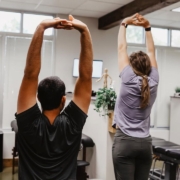The Importance of Stretching: Unleash the Benefits for Your Body
Stretching is often an overlooked aspect of fitness and wellness. We tend to focus on cardio workouts, strength training, or other forms of exercise, but incorporating a regular stretching routine into your fitness regimen can yield numerous benefits for your overall health and well-being. In this blog, we’ll explore the importance of stretching and how it can positively impact your body and daily life.
-
Improved Flexibility
One of the most apparent benefits of stretching is improved flexibility. Flexibility is the range of motion in your joints and muscles. By regularly stretching, you can gradually increase your flexibility, making it easier to perform everyday tasks and exercises with proper form.
Increased flexibility can also reduce the risk of injuries during physical activities. When your muscles and joints can move freely through their full range of motion, you are less likely to strain or pull them.
-
Enhanced Range of Motion
Stretching helps to increase your range of motion, which is crucial for maintaining mobility and functionality as you age. Activities such as reaching, bending, and twisting become easier when your joints are supple and well-lubricated. This increased range of motion can significantly improve your quality of life by allowing you to move more comfortably and perform various activities effortlessly.
-
Stress Reduction
Stretching not only benefits your physical health but also has a positive impact on your mental well-being. Engaging in a stretching routine can help reduce stress and promote relaxation. When you stretch, you release tension in your muscles and stimulate the release of endorphins, the body’s natural mood-enhancers. This can leave you feeling more relaxed, focused, and in a better mood.
-
Improved Posture
In today’s sedentary world, many of us spend hours hunched over computers or slouched in front of the television. This can lead to poor posture, which can, in turn, cause various health issues, such as back pain and muscle imbalances. Stretching can counteract the negative effects of poor posture by targeting specific muscle groups, helping to realign your body and improve your posture over time.
-
Enhanced Circulation
Stretching increases blood flow to your muscles, which can improve circulation throughout your body. Better circulation means more oxygen and nutrients are delivered to your muscles, helping them function optimally. Improved blood flow can also aid in the removal of waste products and toxins from your muscles, reducing muscle soreness and promoting recovery after exercise.
-
Injury Prevention
Regular stretching can significantly reduce the risk of injuries, especially during physical activities or sports. When your muscles are flexible and well-conditioned, they can better withstand the stresses and strains associated with exercise. Stretching can also help to identify and address muscle imbalances and tightness, which can lead to injuries if left unattended.
-
Better Athletic Performance
For athletes, stretching is a vital component of their training regimen. It can improve athletic performance by increasing flexibility, range of motion, and muscle coordination. Incorporating dynamic stretching before a workout and static stretching after can help athletes prepare their bodies for physical demands and aid in recovery afterward.
Conclusion
Incorporating regular stretching into your daily routine is a simple yet effective way to promote your overall health and well-being. It offers a wide range of benefits, from improved flexibility and posture to reduced stress and injury prevention. Whether you’re an athlete looking to enhance your performance or someone seeking better mobility and a higher quality of life, stretching is an essential practice that can help you achieve your goals. So, take a few minutes each day to stretch and reap the rewards of a healthier, more flexible body.




